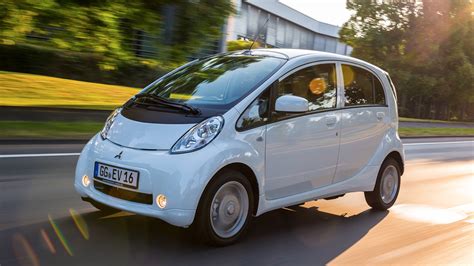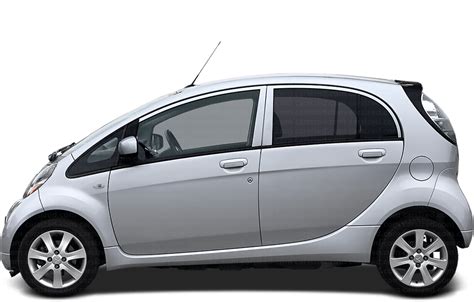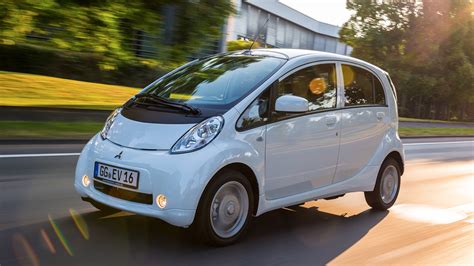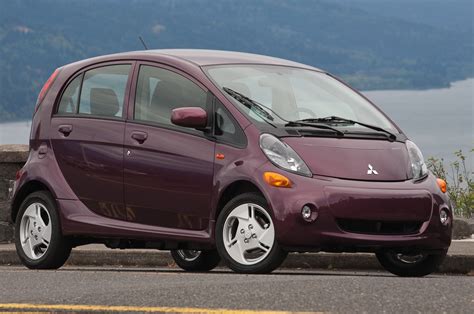Mitsubishi I-miev problems

The Mitsubishi i-MiEV (MiEV is an acronym for Mitsubishi innovative Electric Vehicle) is a five-door electric kei car produced in the 2010s by Mitsubishi Motors, and is the electric version of the Mitsubishi i. Rebadged variants of the i-MiEV are also sold by PSA as the Peugeot iOn and Citroën C-Zero, mainly in Europe. The i-MiEV was the world's first modern highway-capable mass production electric car.
The i-MiEV was launched for fleet customers in Japan in July 2009, and on April 1, 2010, for the wider public. International sales to Asia, Australia and Europe started in 2010, with further markers in 2011 including Central and South America. Fleet and retail customer deliveries in the U.S. and Canada began in December 2011. The American-only version is larger than the Japanese version and has several additional features.
According to the manufacturer, the i-MiEV all-electric range is 160 kilometres (100 mi) on the Japanese test cycle. The range for the 2012 model year American version is 62 miles (100 km) on the United States Environmental Protection Agency's (US EPA) cycle. In November 2011 the Mitsubishi i ranked first in EPA's 2012 Annual Fuel Economy Guide, and became the most fuel efficient EPA certified vehicle in the U.S. for all fuels ever, until it was surpassed by the Honda Fit EV in June 2012 and the BMW i3, Chevrolet Spark EV, Volkswagen e-Golf, and Fiat 500e in succeeding years.
As of July 2014, Japan ranked as the leading market with over 10,000 i-MiEVs sold, followed by Norway with more than 4,900 units, France with over 4,700 units, Germany with more than 2,400 units, all three European countries accounting for the three variants of the i-MiEV family sold in Europe; and the United States with over 1,800 i-MiEVs sold through August 2014. As of early March 2015, and accounting for all variants of the i-MiEV, including the two minicab MiEV versions sold in Japan, global sales totaled over 50,000 units since 2009.

Social links
Mitsubishi I-miev model years


Common Mitsubishi I-miev problems
The Mitsubishi i-MiEV, an innovative electric vehicle introduced in 2009, has been praised for its simplicity and lower maintenance costs compared to gasoline counterparts due to fewer moving parts. However, some model years have faced specific issues.
One of the main issues reported by Consumer Reports is related to the brake assist vacuum pump. Water could penetrate this pump, leading to corrosion and potential failure.
Another concern with the 2012 Mitsubishi i-MiEV is its reliability, which is not well-documented. Consumer Reports has no detailed reliability data for this model year, and anecdotal evidence may not be an objective gauge of reliability.
The 2013 Mitsubishi i-MiEV is another model year to avoid, as it shares many of the same issues as the 2012 model, including the brake vacuum pump failure and slow acceleration.
The 2014 Mitsubishi i-MiEV has limited documentation regarding its reliability, with no recorded complaints on CarComplaints.com and mixed reviews on sites like Edmunds and Reddit.
In summary, the Mitsubishi i-MiEV has faced various issues, particularly in the 2012 and 2013 model years, related to the brake assist vacuum pump, slow acceleration, and reliability. Potential buyers should be aware of these problems and consider their needs carefully when choosing an i-MiEV model year.

How reliable are the Mitsubishi i-MiEV?
Reliability-wise, the Mitsubishi i-MiEV holds up well. One of the key advantages of electric vehicles is their simplicity compared to their gasoline counterparts. With fewer moving parts, there's less that can go wrong, which can lead to lower maintenance costs over time.
What is the recall on the MiEV?
2017 Mitsubishi i-MiEV Recall
(MMNA) is recalling certain 2012-2017 i-MiEV vehicles. Water may penetrate the brake assist vacuum pump, causing corrosion and a failure of the brake vacuum pump. Action Need To Fix It: MMNA will notify owners, and dealers will replace the brake vacuum pump, free of charge.
Why was Mitsubishi i-MiEV discontinued?
Mitsubishi representative Erica Rasch told the publication, "2017 was the last model year for the i-MiEV, and all available retail units have been sold." The news of the i-MiEV's demise, frankly, comes as little surprise considering the car's aforementioned, record-setting lack of speed, a mere 62 miles of range, ...
How long does Mitsubishi i-MiEV last?
| Mitsubishi i-MiEV | |
|---|---|
| Transmission | Single speed reduction gear |
| Battery | 16 kWh / 58 MJ (Li-ion battery) |
| Range | 160 km (99 mi) (Japanese cycle) 100 km (62 mi) (US EPA cycle) |
| Plug-in charging | 15 A 240 V AC (3.6 kW) on the SAE J1772-2009 inlet, optional CHAdeMO DC rapid charging, adapters for domestic AC sockets (110–240 V) |
Latest 5 recalls Mitsubishi I-miev
The National Highway Traffic Safety Administration (NHTSA) has issued 8 recalls for different components of the Mitsubishi I-miev.You can explore the year of the Volkswagen Jetta you are interested in by selecting it from the list.
- Model: Mitsubishi I-miev 2012
- Report Received Date: 2019-11-08
- Manufacturer: Mitsubishi Motors North America, Inc.
- Components: SERVICE BRAKES, HYDRAULIC:POWER ASSIST:VACUUM
- Summary: Mitsubishi Motors North America, Inc. (MMNA) is recalling certain 2012-2017 i-MiEV vehicles. Water may penetrate the brake assist vacuum pump, causing corrosion and a failure of the brake vacuum pump.
- Consequence: Without the brake vacuum pump, the driver will experience a sudden loss of braking assist, lengthening the distance needed to stop the vehicle and increasing the risk of a crash.
- Remedy: MMNA will notify owners, and dealers will replace the brake vacuum pump, free of charge. The recall began January 7, 2020. Owners may contact MMNA customer service at 1-888-648-7820. MMNA's number for this recall is SR-19-002.
- Model: Mitsubishi I-miev 2017
- Report Received Date: 2019-11-08
- Manufacturer: Mitsubishi Motors North America, Inc.
- Components: SERVICE BRAKES, HYDRAULIC:POWER ASSIST:VACUUM
- Summary: Mitsubishi Motors North America, Inc. (MMNA) is recalling certain 2012-2017 i-MiEV vehicles. Water may penetrate the brake assist vacuum pump, causing corrosion and a failure of the brake vacuum pump.
- Consequence: Without the brake vacuum pump, the driver will experience a sudden loss of braking assist, lengthening the distance needed to stop the vehicle and increasing the risk of a crash.
- Remedy: MMNA will notify owners, and dealers will replace the brake vacuum pump, free of charge. The recall began January 7, 2020. Owners may contact MMNA customer service at 1-888-648-7820. MMNA's number for this recall is SR-19-002.
- Model: Mitsubishi I-miev 2017
- Report Received Date: 2017-12-08
- Manufacturer: Mitsubishi Motors North America, Inc.
- Components: AIR BAGS:FRONTAL:PASSENGER SIDE:INFLATOR MODULE
- Summary: Mitsubishi Motors North America, Inc. (MMNA) is recalling all 2016-2017 i-MiEV vehicles, equipped with certain air bag inflators assembled as part of the passenger frontal air bag modules used as original equipment or replacement equipment. In the event of a crash necessitating deployment of the passenger frontal air bag, these inflators may rupture due to propellant degradation occurring after long-term exposure to absolute humidity and temperature cycling.
- Consequence: An inflator rupture may result in metal fragments striking the vehicle occupants resulting in serious injury or death.
- Remedy: MMNA will notify owners, and dealers will replace the passenger side frontal air bag inflator, free of charge. The recall began on December 15, 2017. Owners may contact MMNA customer service at 1-888-648-7820. MMNA's number for this recall is SR-17-008.
- Model: Mitsubishi I-miev 2012
- Report Received Date: 2017-01-10
- Manufacturer: Mitsubishi Motors North America, Inc.
- Components: AIR BAGS:FRONTAL:PASSENGER SIDE:INFLATOR MODULE
- Summary: Mitsubishi Motors North America, Inc. (MMNA) is recalling certain 2012 and 2014 i-MiEV vehicles. These vehicles are equipped with certain air bag inflators assembled as part of the passenger frontal air bag modules used as original equipment or replacement equipment. In the event of a crash necessitating deployment of the front air bags, these inflators may rupture due to propellant degradation occurring after long-term exposure to absolute humidity and temperature cycling.
- Consequence: An inflator rupture may result in metal fragments striking the vehicle occupants resulting in serious injury or death.
- Remedy: MMNA will notify owners, and dealers will replace the front passenger air bag inflator, free of charge. The recall began on March 10, 2017. Owners may contact MMNA customer service at 1-888-648-7820. MMNA's number for this recall is SR-17-001.
- Model: Mitsubishi I-miev 2012
- Report Received Date: 2015-09-23
- Manufacturer: Mitsubishi Motors North America, Inc.
- Components: AIR BAGS
- Summary: Mitsubishi Motors North America, Inc. (Mitsubishi) is recalling certain model year 2014 Mitsubishi Mirage vehicles manufactured July 27, 2013, to November 20, 2013, and 2012 Mitsubishi i-MiEV vehicles manufactured October 28, 2011, to September 7, 2012. Due to an increased resistance in the impact sensor for the air bag system, in the event of a crash necessitating deployment of the frontal, side and/or curtain air bags when the SRS warning is illuminated, the frontal air bag may have a delayed deployment and/or the side and curtian air bag may not deploy at all.
- Consequence: In the event of a crash, an air bag that does not deploy or deploys late, increases the risk of occupant injury.
- Remedy: Mitsubishi will notify owners, and dealers will replace the affected impact sensors, free of charge. The recall began on November 5, 2015. Owners may contact Mitsubishi customer service at 1-888-648-7820. Mitsubishi's number for this recall is SR-15-011.
Latest negative Mitsubishi I-miev car reviews
Latest positive Mitsubishi I-miev car reviews
-

Vehicle year: 2012
I've had this car for half a year now, and with only 2800 miles on it, it's become the primary car for our family. Our two kids absolutely love it! I must say, owning and driving an EV has completely changed my perspective. Going to a gas station is now a thing of the past, and range anxiety is a non-issue. I've learned that with just a little bit of planning, I can easily take trips up to 75-80 miles without any worries. If I need to go further, I simply take our Jetta TDI. Recently, I even took my iMiEV on a long trip to test its range, driving up to 40 MPH without A/C. I was thrilled to find that I was able to get 93.4 miles with 1 mile remaining - no need to reach for the hidden reserves! And let me tell you, driving this car is an absolute blast!
-

Vehicle year: 2017
I've only owned this car for a month, but I have no regrets. Since buying it, I've hardly used my other vehicle. The car has enough torque and acceleration to pull away from the crowd at traffic lights if you want to. While it may not be the most comfortable for all-day driving, it's perfectly adequate for an hour or less. Although the initial cost may be higher compared to other compact cars, the eventual total cost of ownership is calculated to be lower. It's worth paying a little more upfront for greater benefits down the road. Additionally, the vehicle is very stable since the wheels are located at the corners.
-

Vehicle year: 2017
Wow, it sounds like you had an amazing experience with your new vehicle! From Virginia to Eastern Pennsylvania, through wicked storms and heavy traffic, your car handled it all like a dream. And the best part? You were able to stop at Nissan dealers for free charges on the way home, which cost you absolutely nothing! That's incredible! With an average cost of only $2.51 per 100 miles or $12.55 for 500 miles of driving, you really can't beat it. Plus, if you fill it up overnight, the cost goes even lower. It sounds like you made a fantastic purchase that will serve you well for work and beyond!
-

Vehicle year: 2012
We've had the car for over two months now and have already put over 5000 km on it. We're thrilled to report that the car has exceeded our expectations in terms of performance, and it's our only car. It's comfortable, offers great visibility, and is incredibly quiet. If we need to go on any long trips, we plan to swap for or rent a gas car. As two drivers sharing this one electric car, we've already saved a significant amount of money on fuel bills. While there was an adjustment period to get comfortable with the range limits, we've had no problem driving our regular routes, including our work commute, shopping, and family visits. Once we got familiar with the charging station locations, we started enjoying taking longer trips and venturing further and further. Overall, it's a fantastic all-around car!
-

Vehicle year: 2012
I have had this car over six weeks now and use it for my daily commute of 45 kilometers (27 miles) each way, putting on sometimes well over 100 kilometers with a few bars in the power gauge to spare.This car is very comfortable and has all the features of a modern vehicle.Don't believe the spin that this car is lacking in anything, this car is truly reaching greater masses as the affordable alternative to the high priced electric cars now being offered by other manufacturers.This car is well designed and has plenty of power with a lot of range.This is the one that scares the oil companies and the car repair shops.
Are you having problems with your Mitsubishi I-miev?



Andre Morissette 2024-09-28
Vehicle year: 2017
After 2 weeks of daily driving, I am still as satisfied as the first day I got my i-MiEV. It is easy to park, comfortable for its size, and the best part is that it requires NO GAS! If I may suggest some improvements for the i-MiEV engineers, it would be to improve the noise isolation from outside. When in traffic, one can hear outside noise even with the windows closed. Additionally, the suspension/stability could be improved to make freeway commuting smoother and minimize susceptibility to strong winds. Overall, I am very satisfied with the i-MiEV and I highly recommend it if your routine commute is within 50-60 miles in between charges.
Johann Volkman 2024-09-08
Vehicle year: 2012
If San Diego Gas and Electric is your utility, then this review applies. I was one of the first adopters in my S. O'side neighborhood. Since an electric car was an experiment, and no used ones available yet in my local area, I took a plunge on the $12K 2012 Mitsubishi (you can get a $7,500 Federal tax rebate and a $2,500 California credit). Even with the special SDG&E EV rates (which require you to charge only at night or pay a penalty), I am averaging 20 miles/$. The Mitsu Mirage gets 50 mpg which at the current price of $3/gallon, works out to 16 miles/$. At around 30K miles, my range is down about 10%. I figure by 40K miles (next year sometime), the car will not be worth keeping unless Mitsubishi honors the battery warranty. Since a replacement battery is $10K (or so), and the car is worth around $4K on Craigslist now, my car has depreciated around $2K/year. I figure I am saving $195 (difference between a year's gas at today's prices in the Mirage vs. the i-MiEV electricity cost). I looked at used Mirages, and they depreciate less, and, are able to get you to work and back after 40K miles. I wonder what California will do with all of the 4 and 5 year old electric cars that are just now trickling into junk yards (Leaf battery exchange is ONLY $5,500-parts only). Will I buy another electric? Heck yeah, but let's see how the 200-mile latest and greatest (Chevy Bolt or Tesla Model 3) holds up first. Sometime in 2018, I'll have to switch to driving my Mitsubishi SUV to work. One last thing, there are so many electric cars in Southern California now that the carpool isn't any faster when traffic is at its worst. Jan 2018 update: Just hit 30K and my range is down 20%. I am just able to make it to work and back. The car still looks great.Too bad some third party doesn't make battery replacements. July 2018 update: I have not noticed any further drop in range. Maybe it's because it is warmer and the car seems to go further in warmer temperatures. Unfortunately, my plant manager won't let me plug my car in at work anymore. I was using an outlet on the side of the building since we have no dedicated EV charger. Now I have to drive my other car whenever I need to go somewhere at lunch or after work since my range has been reduced to getting me to work and back and not much else. For your information, a lot of early Leafs are hitting the junkyard because California hasn't grasped the fact that owners need help funding battery replacements. However, this means I can pick up spare chargers pretty cheap now.
Mckenna Kirlin 2024-07-07
Vehicle year: 2012
After 2 weeks of daily driving, I am still as satisfied as the first day I got my i-MiEV. It is easy to park, comfortable for its size, and the best part is that it requires NO GAS! If I may suggest some improvements for the i-MiEV engineers, it would be to improve the noise isolation from outside. When in traffic, one can hear outside noise even with the windows closed. Additionally, the suspension/stability could be improved to make freeway commuting smoother and minimize susceptibility to strong winds. Overall, I am very satisfied with the i-MiEV and I highly recommend it if your routine commute is within 50-60 miles in between charges.
Brook Abernathy 2024-05-15
Vehicle year: 2017
Hi there! I hope you're doing well. I wanted to share my experience with my Mitsubishi Miev that I bought back in 2013. It's a great car that has served me well over the years, despite being a bit basic. However, I've noticed that the battery range has declined quite a bit over time, which is a bit disappointing. Even though I don't drive it very often, the range has dropped to around 35-40 miles inconsistently. I was really counting on the 10-year battery warranty, but unfortunately, Mitsubishi has refused to honor it. I think it's important to consider this when buying an electric vehicle, and I would recommend looking into other companies. Thanks for listening!
Blake Bergstrom 2024-04-14
Vehicle year: 2017
If San Diego Gas and Electric is your utility, then this review applies. I was one of the first adopters in my S. O'side neighborhood. Since an electric car was an experiment, and no used ones available yet in my local area, I took a plunge on the $12K 2012 Mitsubishi. Even with the special SDG&E EV rates, which require you to charge only at night or pay a penalty, I am averaging 20 miles/$. The Mitsu Mirage gets 50 mpg which at the current price of $3/gallon, works out to 16 miles/$. At around 30K miles, my range is down about 10%. I figure by 40K miles, the car will not be worth keeping unless Mitsubishi honors the battery warranty. Since a replacement battery is $10K, and the car is worth around $4K on Craigs List now, my car has depreciated around $2K/year. I looked at used Mirages, and they depreciate less, and, are able to get you to work and back after 40K miles. I wonder what California will do with all of the 4 and 5 year old electric cars that are just now trickling into junk yards. Will I buy another electric? Heck yeah, but let's see how the 200-mile latest and greatest (Chevy Bolt or Tesla Model 3) holds-up first. Sometime in 2018, I'll have to switch to driving my Mitsubishi SUV to work. One last thing, there are so many electric cars in S. Calif. now that the carpool isn't any faster when traffic is at its worst. Jan 2018 update: Just hit 30K and my range is down 20%. I am just able to make it to work and back. Car still looks great.Too bad some third party doesn't make battery replacements. July 2018 update: I have not noticed any further drop in range. Maybe it's because it is warmer and the car seems to go further in warmer temperatures. Unfortunately, my plant manager won't let me plug my car in at work anymore. I was using an outlet on the side of the building since we have no dedicated EV charger. Now I have to drive my other car whenever I need to go somewhere at lunch or after work since my range has been reduced to getting me to work and back and not much else. For your information, a lot of early Leafs are hitting the junkyard because California hasn't grasped the fact that owners need help funding battery replacements. However, this means I can pick up spare chargers pretty cheap now.